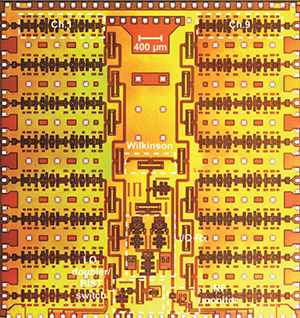With Phased-Array Radar Technologies, UC San Diego Electrical Engineers Aim to Make Car Travel Safer
San Diego, Oct. 28, 2014 — Making the world safer for car drivers, passengers and pedestrians is the ultimate goal of automotive safety systems and self-driving cars. To get there, electrical engineers from the University of California, San Diego developed hardware for a new generation of automotive radar systems designed to keep drivers, and the pedestrians around them they may not see, safe.

The hardware development project at UC San Diego is part of an initiative led by Toyota Technical Center, Ann Arbor, MI that won a 2014 R&D 100 Award from R&D Magazine for its “Automotive Phased Array Radar.” The system could eventually be incorporated into both human-driven cars as well as driverless cars of the future.
The electrical engineering researchers at the UC San Diego Jacobs School of Engineering developed advanced automotive phased-array radar technologies which are a key element in the high-precision automotive radar system recognized by R&D Magazine.
The advanced hardware builds on years of previous research from UC San Diego electrical engineering professor Gabriel Rebeiz, a leader in phased-array technology research and academic participant in Calit2's Qualcomm Institute. According to Rebeiz, the system marks the first time that RF beamforming phased-array technologies, which are coordinated groups of directional antennas often used in satellite and defense applications, have been integrated into radar systems for civilian automobiles.
The new automotive radar system captures high-resolution images of an approximately 100-meter area surrounding a moving car. This information is far more detailed than what is available from the first-generation automotive radar systems that are installed in many of today’s cars and assist with things like changing lanes and maintaining safe distance from other cars. (Rebeiz also led a team that worked on aspects of the hardware for these first-generation radar systems, though he has been more deeply involved in this second-generation project.)
According to R&D Magazine, “Toyota Motor Corp. is the first to manufacture an Automotive Phased Array Radar (APAR) that satisfies the requirements for widespread use in vehicle safety systems while also providing a wide 100-degree sensing arc capable of effectively detecting pedestrians. Developed by Toyota Technical Center, the Univ. of California, San Diego, Fujitsu-Ten and the Michigan Technological Research Institute, APAR features a single, silicon germanium radio frequency integrated circuit (RFIC) package optimized for high-frequency 77-GHz signals and high-temperature operation.”
More Details via Phased Arrays
Rebeiz described the experimental phased array radar system as somewhat like a telescope or a “zoom” lens. The array of antennas moves left and right in a regular pattern across the area surrounding the car, capturing high-resolution images of what is happening with less than a micro-second delay. This is a departure from today’s radar systems, which act more like wide-angle lenses which pick up less detail.
“If you have a large wide-angle lens, you are collecting all this bright light; you will not see the faint light of a person standing in front of a truck or car. The second generation automotive radar systems will provide much more precise images,” Rebeiz explained. “The difference is the high resolution and dynamic range.”
According to Rebeiz, the next-generation radar system can track pedestrians next to large objects such as walls and trucks, and it can “see” pedestrians crossing the road even when obstructed by a car. The system can also image a car in front of the radar, and determine if doors are open or closed.
Rebeiz predicts that it will be another five years or so before this technology makes it to cars available for purchase. While the system has been built and demonstrated, there is additional safety testing, software, firmware and systems-integration work to do. (Rebeiz and his team are not involved in these aspects of the project.)
A Radar System on a Chip
The principles behind this next-generation automotive radar are similar to those of traditional radar systems that have been in use for decades in aircraft and satellites. Bringing down the cost was one of the big challenges in developing phased array hardware for automotive radar systems. While a $50,000 radar system for an airplane may be acceptable, that’s far too expensive for a car.

Rebeiz framed the challenge as follows. “How do you make a low-cost automotive radar system?”
The UC San Diego electrical engineers did the work necessary to get the entire system onto a low-cost single silicon chip. Moving to a single chip reduced packaging costs and increased efficiency and reliability. The researchers also added a built-in self-test feature which won the IEEE 2014 Microwave Prize for the best work published in microwaves in the world. The work involved significant electromagnetic simulations, circuit design, system-level design, advanced board design as well as fine engineering design.
The system operates at 77 Giga Hertz, which is in the millimeter-wave range of the electromagnetic spectrum, and is the internationally allowed spectrum for automotive radars. Researchers are also leveraging this section of the electromagnetic spectrum for ultra-high-data-rate point-to-point wireless communications.
“It’s a powerful system,” said Rebeiz. “The system produces really high resolution images of the scene around the car, which will be important for safer human-driven cars and for self-driving cars.”
The UC San Diego Research Team
The UC San Diego electrical engineering graduate students and postdoctoral researchers who worked with Rebeiz on this project include:
Yusuf Atesal, a UC San Diego electrical engineering PhD alumnus now at ADI.
Ozgur Inac, a UC San Diego electrical engineering PhD alumnus now at Intel.
Sang-Young Kim, a UC San Diego electrical engineering PhD alumnus now at Marvel.
Bon-Hyun Ku, a UC San Diego electrical engineering Post-Doctoral Fellow now at Qualcomm.
Woorim Shin, a UC San Diego electrical engineering PhD alumnus now at Qualcomm.
Academic Papers
A subset of publications from the Rebeiz lab related to this project is listed below.
“A Phased Array RFIC With Built-In Self-Test Capabilities,” IEEE Transactions on Microwave Theory and Techniques, Jan. 2012, (PDF) by Ozgur Inac, Donghyup Shin and Gabriel M. Rebeiz from the Department of Electrical and Computer Engineering at the UC San Diego Jacobs School of Engineering. (This paper won the 2014 Microwave Prize from the IEEE Microwave Theory and Techniques Society.)
“A 76-84 GHz 16-Element Phased Array Receiver with a Chip-Level Built-In Self-Test System,” by Sang Young Kim, Ozgur Inac, Choul-Young Kim, Donghyup Shin and Gabriel M. Rebeiz, IEEE Transactions on Microwave Theory and Techniques, vol. 61, no. 8, pp. 3083-3098, August 2013 (PDF).
“A 77-81 GHz 16-Element Phased-Array Receiver with +/-50° Beam Scanning for Advanced Automotive Radars,” by Bon-Hyun Ku, Paul Schmalenberg, Ozgur Inac, Ozan D. Gurbuz, Jae Seung Lee, Koji Shiozaki, and Gabriel M. Rebeiz in IEEE Transactions on Microwave Theory and Techniques, vol. 62, no. 11, November 2014 (PDF).
Media Contacts
Daniel Kane, Jacobs School of Engineering, dbkane@ucsd.edu
Related Links
R&D Magazine R&D 100 Winners
R&D Magazine Radar Pedestrian Safety

